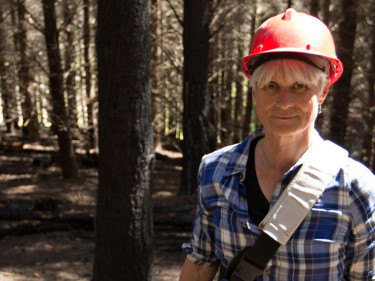Landscaping with fire-resistant plants
Most homeowners want to create a landscape that complements their home and has variations in colour, texture, flowers and foliage. When selecting plants, you also should consider the flammability of plants, particularly if your home is located near a forest or bush.
You can minimise or reduce fire hazard around your home by using fire-resistant plants in the landscape. Equally important is where you plant, how plants are spaced and ongoing maintenance. When done correctly, you can create a fuel break and help protect your home by blocking intense heat.
Plant flammability
Fire-resistant plants aren’t fireproof but they do not readily ignite and have the following characteristics:
- moist, supple leaves
- little dead wood and dry, dead material doesn’t accumulate within the plant
- watery sap that doesn’t have a strong odour
- low levels of sap or resin.
Most deciduous trees and shrubs are fire-resistant.

Highly flammable plants can have the following characteristics:
- contain fine, dry, or dead material with-in the plant, such as twigs, needles and leaves.
- leaves, twigs, and stems contain volatile waxes, terpenes or oils
- aromatic leaves
- sap is gummy, resinous and has a strong odour
- loose or papery bark.

Avoid planting highly flammable plants such as manuka, kanuka and eucalyptus around your home.
Flammability of native New Zealand species
Both native and non-native plants can be highly flammable. Scion Rural Fire Research conducted research on the flammability of native New Zealand plants.
Experienced fire managers throughout New Zealand ranked a list of native species in terms of flammability based on their observations at wildfires and prescribed burns under different fire danger conditions. Scion subjected their responses to statistical analysis and assigned species to the following flammability classes.
These flammability classes are intended as a guide only. Species flammability can vary depending on age, genetic and environmental factors. For example, flammability may increase under drought or in certain weather conditions and mature vegetation may carry more dead material, making a fire more severe.
Below are the flammability classes and, based on the Scion findings, the native species within each class.
Low flammability species are suitable for green breaks or safety zones, but when in the immediate vicinity of structures, there should be at least a 3-4 metre break between the crowns to reduce fuel continuity. Native species include:
- fuchsia excorticate - commonly known as tree fuchsia, New Zealand fuchsia and kotukutuku
- pseudopanax crassifolius - commonly called as horoeka or lancewood
- pseudopanax arboreus – commonly called five finger, puahou or whauwhaupaku
- coprosma robusta – commonly called karamu
- coprosma grandifolia – commonly called kanono or raurēkau
- geniostoma ligustrifolium - commonly called hangehange
- coprosma australis – commonly called kanono or raurēkau
- coprosma repens – commonly called tree bedstraw, taupata, mirror bush, looking-glass bush, New Zealand laurel and shiny leaf
- carpodetus serratus – commonly called putaputawētā, marbleleaf and bucket-of-water-tree
- corynocarpus laevigatus – commonly called karaka or New Zealand laurel
- griselinia littoralis - commonly called kapuka, New Zealand broadleaf or papauma
- griselinia lucida - commonly called puka, akapuka or shining broadleaf
- macropiper excelsum – commonly called pepper tree and kawakawa
- solanum aviculare - commonly called New Zealand nightshade and poroporo.
Low to moderately flammable species are not recommended for planting in green breaks. If planted in defensible space, elevated dead material and litter should be removed regularly, more than 4 metres should be left between tree crowns, and trees or shrubs in this category should not be within 10 metres of a structure. Native species include:
- hebe salicifolia - commonly called willow-leaf hebe
- hebe stricta - commonly called koromiko
- melicytus lanceolatus - commonly called narrow-leaved māhoe or māhoe-wao
- melicytus ramiflorus – commonly called whiteywood and māhoe
- aristotelia serrata - commonly called wineberry, makomako or mako
- coriaria arborea – commonly called tutu
- myoporum laetum - commonly called ngaio or mousehole tree
- pittosporum crassifolium – commonly called karo
- pittosporum eugenioides - commonly called lemonwood or tarata
- hoheria - includes six species commonly called manatu, lacebark and ribbonwood
- knightia excels - commonly called rewarewa
- nothofagus menziesii - commonly called silver beech and tawhai
- phyllocladus glaucus – commonly called toatoa and blue celery pine
- plagianthus regius – commonly called ribbonwood and manatu but is also known as houi, manaui manatu, puruhi and whauwhi
- weinmannia racemose - commonly called kamahi.
Moderately flammability species tend to produce heavy accumulations of flammable litter and elevated dead material, and/or have flammable green foliage. These are not recommended for green breaks or for planting in safety zone. Native species include:
- beilschmiedia tawa - commonly called the tawa tree
- cordyline australis – commonly called cabbage tree, cabbage-palm or tī kōuka
- pittosporum tenuifolium - commonly called kōhūhū, black matipo, kohukohu and tawhiwhi
- dacrydium cupressinum – commonly called rimu
- metrosideros umbellate – commonly called the southern rātā
- agathis australis – commonly called the kauri
- phormium – two species commonly called harakeke, New Zealand flax or flax lily
- podocarpus dacrydioides – commonly called kahikatea and white pine
- weinmannia silvicola – commonly called tōwai or tawhero.
Moderate to high flammability species may have flammable green foliage and/or produce a lot of litter and fuel. These are not recommended for green breaks or safety zones. Native species include:
- podocarpus totara – commonly called totara and kahikatea
- dodonaea viscosa – commonly called ake ake or hopbush
- cyathea & dicksonia – includes several species of tree ferns
- cyathodes fasciculate – commonly called tall mingimingi.
High flammability species burn readily at low to moderate forest fire danger conditions. Not recommended for green breaks or safety zones. Native species include:
- kunzea ericoides – commonly called kanuka
- leptospermum scoparium – commonly called manuka.














